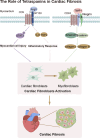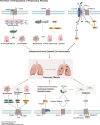The role of tetraspanins in organ fibrosis: mechanisms and therapeutic perspectives
- PMID: 40993816
- PMCID: PMC12462079
- DOI: 10.1186/s12967-025-06890-9
The role of tetraspanins in organ fibrosis: mechanisms and therapeutic perspectives
Abstract
Fibrosis, caused by excessive extracellular matrix (ECM) deposition, is a major contributor to organ dysfunction and mortality. Tetraspanins (TSPANs) have emerged as key regulators of fibrotic processes across various organs. This review examines the roles of TSPANs (e.g., TM4SF5, CD151, CD63, and CD9) in fibrosis in the liver, heart, lungs, kidneys, skin, and cornea, focusing on their influence on fibroblast activation, epithelial-mesenchymal transition (EMT), inflammation, and ECM remodeling through TGF-β/Smad, STAT3, and integrin signaling. Potential TSPAN-targeted therapies, such as monoclonal antibodies, RNA silencing, and exosome engineering are also evaluated. Despite promising preclinical results, challenges remain in tissue specificity, delivery, and clinical application for TSPAN-based antifibrotic therapies.
Keywords: Epithelial-Mesenchymal transition; Extracellular matrix; Organ fibrosis; Tetraspanins; Therapeutic perspectives.
Conflict of interest statement
Declarations. Ethics approval and consent to participate: Not applicable. Consent for publication: We give our consent for the manuscript to be published in Cell Communication and Signaling. Competing interests: The authors declare that they have no competing interests.
Figures







References
-
- Weiskirchen R, Weiskirchen S, Tacke F. Organ and tissue fibrosis: molecular signals, cellular mechanisms and translational implications. Mol Aspects Med. 2019;65:2–15. - PubMed
-
- Rockey DC, Longo DL, Bell PD, Hill JA. Fibrosis — A common pathway to organ injury and failure. N Engl J Med. 2015;372:1138–49. - PubMed
Publication types
Grants and funding
- 2024NSFSC0580/Sichuan Science and Technology Program
- 2023NSFSC1840/Sichuan Science and Technology Program
- 2022YFS0578, 2022YFS0614/Sichuan Science and Technology Program
- U23A20398, 82030007/National Natural Science Foundation of China
- 2022ZYD0057/The Central Government Guides Local Science and Technology Development Project
LinkOut - more resources
Full Text Sources
Miscellaneous

